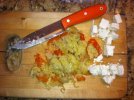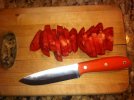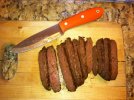I'm new to carving feather sticks. Maybe it's the wood I'm using (juniper?), but it's not easy to do. Most of my shavings fall off the stick. Today I tried carving with four knives:
CS True Flight - had a hard time. I think the bevel is too obtuse to be a good carver. I need to re-profile the last inch of the blade to make it a better carver. It could baton all day, though.
SAK Tinker - Did well with the large blade, but it was hard to control the evenness of the stroke and thickness of the shaving.
VTech Neck Knife - This is a cheap 4" fixed blade made of 440. It has a hollow ground blade. It cut with more authority than the SAK, but still was hard to control the angle of attack.
Mora 511 - The easiest to cut consistently with. I had significantly more control, which I attribute to the Scandi grind. Correct me if I'm wrong.
Do you guys share my impression that Scandi grind makes feather sticking easier?
P.S. I just tried out my CS frontier hawk that I reprofiled for a more acute bevel. It did pretty well, but is tiring to use because the edge is further from the handle.
CS True Flight - had a hard time. I think the bevel is too obtuse to be a good carver. I need to re-profile the last inch of the blade to make it a better carver. It could baton all day, though.
SAK Tinker - Did well with the large blade, but it was hard to control the evenness of the stroke and thickness of the shaving.
VTech Neck Knife - This is a cheap 4" fixed blade made of 440. It has a hollow ground blade. It cut with more authority than the SAK, but still was hard to control the angle of attack.
Mora 511 - The easiest to cut consistently with. I had significantly more control, which I attribute to the Scandi grind. Correct me if I'm wrong.
Do you guys share my impression that Scandi grind makes feather sticking easier?
P.S. I just tried out my CS frontier hawk that I reprofiled for a more acute bevel. It did pretty well, but is tiring to use because the edge is further from the handle.
Last edited:






